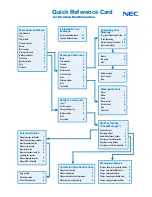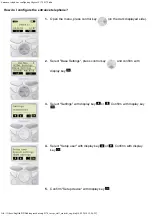
Receiver Rear Panel
Receiver Front Panel
Operation
For handheld transmitters, insert the supplied 2 x AA batteries by carefully unscrewing the base to reveal the battery compartment inside the
microphone body, slide the batteries into the compartment (note: negative towards top of microphone) one behind the other and replace the
compartment cover. To switch the transmitter on, move the slide switch to the first notch (MUTE)
– the LCD backlight will illuminate – then move
on another notch and the microphone will be switched on, showing the frequency and battery status
– the backlight will go out after a few
seconds.
For beltpacks, squeeze down the clip in the centre of the front panel of the beltpack to unfasten the lower half, which hinges outwards to reveal
the battery compartment. Position the supplied 2 x AA batteries inside ( and - are the correct way round for each) and then close the
battery compartment flap until clipped back into position. If using a neckband or lavalier microphone, ensure that the sensitivity switch is set to
the “mic” setting (the alternative setting is for use with instruments via a jack lead and will be quieter). To activate the transmitter, press and hold
th
e ON / CHECK button (see diagram above) until the word “ON” is displayed – this is replaced by the frequency and battery status. The
backlight will go out after a few seconds, pressing the “ON / CHECK” button momentarily switches the backlight on briefly.
Position the receiver within the best available line of sight to the transmitter(s) and connect the DC jack of the supplied power adapter to the
receiver and the plug-top to the mains outlet. Turn microphone level(s) down on the receiver. Extend both antennae fully upwards and outwards
slightly and press and hold the POWER / IR SYNC. Button for more than 2 seconds
– this will switch the unit on.
Note: for dual sets (with 2 transmitters), both microphones’ outputs will be mixed and fed to both balanced and unbalanced outputs.
Connect the jack or XLR (optional) lead to the receiver’s audio output connector, turn down the volume of any equipment (mixer, amplifier etc.)
that the signal will be fed into and then connect the jack or XLR to the equipment.
Warning! - take care not to point microphones towards speakers
– this can cause damaging feedback (loud whistle or howling noise) – try to
point microphones away from the speaker cabinets.
1. Antennae (detachable BNC)
2. Power adapter input
3. Balanced XLR output
4. Unbalanced 6.3mm jack output
1. Power / IR Sync. button
2. Channel A volume control
3. Channel A frequency up/down
4. Backlit LCD display
5. IR sender
6. Channel B frequency up/down
7. Channel B volume control























